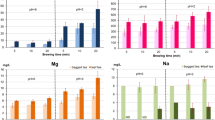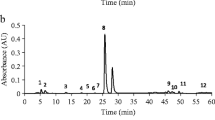Abstract
To evaluate the potential benefits and risks associated with tea consumption it is important to identify the constituents of this beverage. Levels of some minerals, caffeine and catechins in green tea samples commercialized in Portugal were evaluated. Potassium is the metal present in larger amount (92–151 mg/l). The content of sodium, calcium, fluoride, aluminium, manganese and iron were 35–69, 1.9–3.5, 0.80–2.0, 1.0–2.2, 0.52–1.9, 0.020–0.128 mg/l, respectively. Chromium and selenium were not detected. The resulting data showed considerable variability in catechins content. The levels of epigallocatechin gallate (EGCG) ranged from 117 to 442 mg/l, epicatechin 3-gallate (EGC) from 203 to 471 mg/l, epigallocatechin (ECG) from 16.9 to 150 mg/l, epicatechin (EC) from 25 to 81 mg/l and catechin (C) from 9.03 to 115 mg/l. Caffeine contents in the green tea infusions studied were between 141–338 mg/l. Green tea infusions provide significant amounts of catechins and could be an important source of some minerals.
Similar content being viewed by others
Abbreviations
- C:
-
(+) catechin
- EC:
-
(−) epicatechin
- ECG:
-
(−)−epicatechin gallate
- EGC:
-
(−)−epigallocatechin
- EGCG:
-
(−)−epigallocatechin gallate
- HPLC:
-
High-performance liquid chromatography
- M4:
-
(−)-5-(3′,4′, 5′-trihydroxyphenyl)-gamma-valerolactone
- M6:
-
(−)-5-(3′, 4′-dihydroxyphenyl)-gamma-valerolactone
References
MacKay DL, Blumberg JB (2000) The role of tea in human health: an update. J Am Coll Nutr 21:1–13
Chung FL, Schwartz J, Herzog CR, Yang YM (2003) Tea and cancer prevention: studies in animals and humans. J Nutr 133:3268S–3274S
Stagg GV, Millin DJ (1975) The nutritional and therapeutic value of tea—a review. J Sci Food Agric 26:1439–1459
Higdon JV, Frei B (2003) Tea catechins and polyphenols: health effects, metabolism, and antioxidant function. Crit Rev Food Sci Nutr 43:89–143
Yao LH, Jiang YM, Shi J, Tomás-Barberán FA, Datta N, Singanusong R, Chen SS (2004) Flavonoids in food and their health benefits. Plant Foods Hum Nutr 59(3):113–122
Cabrera C, Gimenez R, Lopez MC (2003) Determination of tea components with antioxidant activity. J Agric Food Chem 51(15):4427–4435
Powell JJ, Burden TJ, Thompson RPH (1998) In vitro mineral availability from digested tea: a rich dietary source of manganese. Analyst 123:1721–1724
Hope S-J, Daniel K, Gleason KL, Comber S, Nelson M, Powell J (2006) Influence of tea drinking on manganese intake, manganese status and leucocyte expression of MnSOD and cytosolic aminopeptidase. Eur J Clin Nutr 60:1–8
Xie MY, von Bohlen A, Klockenkämper R, Jian XH, Günther K (1998) Multielement analysis of Chinese tea (Camellia sinensis) by total-reflection X-ray fluorescence. Z Lebensm Unters Forsch A 207:31–38
Fung KF, Zhang ZQ, Wong JWC, Wong MH (1999) Fluoride contents in tea and soil from tea plantations and the release of fluoride into tea liquor during infusion. Environ Pollut 104:197–205
Matsuura H, Hokura A, Katsuki F, Itoh A, Haraguchi H (2001) Multielement determination and speciation of major-to-trace elements in black tea leaves by ICP-AES and ICP-MS with the aid of size exclusion chromatography. Anal Sci 17:391–398
Fernandez-Caceres PL, Martin MJ, Pablos F, Gonzalez AG (2001) Differentiation of tea (Camellia sinensis) varieties and their geographical origin according to their metal content. J Agric Food Chem 49:4775–4779
Behrendt A, Oberste V, Wetzel WE (2002) Fluoride concentration and pH of iced tea products. Caries Res 36:405–410
Fernández PL, Pablos F, Martín MJ, González AG (2002) Multi-element analysis of tea beverages by inductively coupled plasma atomic emission spectrometry. Food Chem 76:483–489
Cleresci LS, Greenberg AE, Eaton AD (2005) Part 3030 E, 3113, 3114 C, 3500-Na, 3500-K and 4500-F. In: APHA-AWWA-WEF (eds) Standard Methods for the Examination of Water and Wastewater. 21st edn, Washington, DC
Fernandez PL, Martin MJ, González AG, Pablos F (2000) HPLC determination of catechins in tea. Differentiation of green, black and instant tea. Analyst 125:421–425
Burns DT, Danzer K, Townsend A (2002) Use of the term “recovery” and “apparent recovery” in analytical procedures (IUPAC Recommendations 2002). Pure Appl Chem 74(11):2201–2205
The United States Pharmacopeia and National Formulary (USP 30-NF 25) (2007) Validation of Compendial Procedures <1225>
Simpson A, Shaw L, Smith AJ (2001) The bio-availability of fluoride from black tea. J Dentistry 29(1):15–21
Samman S, Sandstrom B, Toft MB, Bukhave K, Jensen M, Sorensen SS, Hansen M (2001) Green tea or rosemary extract added to foods reduces nonheme-iron absorption. Am J Clin Nutr 73(3):607–612
Fairweather-Tait SJ (1999) The importance of trace element speciation in nutritional sciences. Fresenius J Anal Chem 363(5–6):536–540
Graham HN (1991) Green tea composition, consumption, and polyphenol chemistry. Prev Med 21:334–350
Balentine DA, Wiseman AS, Bouwens LCM (1997) The chemistry of tea flavonoids. Crit Rev Food Sci Nutr 37(8):693–704
Del Rio D, Stewart AJ, Mullen W, Burns J, Lean ME, Brighenti F, Crozier A (2004) HPLC-MSn analysis of phenolic compounds and purine alkaloids in green and black tea. J Agric Food Chem 52(10):2807–2815
Wang H, Helliwell K, You X (2000) Isocratic elution for the determination of catechins, caffeine and gallic acid in green tea using HPLC. Food Chem 68:115–121
Lin JK, Lin C-L, Liang Y-C, Lin-Shiau S-Y, Juan I-M (1998) Survey of catechins, gallic acid and methylxanthines in green, oolong, pu-erh and black teas. J Agric Food Chem 46:3635–3642
Lin Y-S, Wu S-S, Lin J-K (2003) Determination of tea polyphenols and caffeine in tea flowers (Camellia sinensis) and their hydroxil radical scavenging and nitric oxide suppressing effects. J Agric Food Chem 51:975–980
Toschi TG, Bordoni A, Hrelia S, Bendini A, Lercker G, Biagi PL (2000) The protective role of different green tea extracts after oxidative damage is related to their catechin composition. J Agric Food Chem 48(9):3973–3978
Nawrot P, Jordan S, Eastwood J, Rotstein J, Hugenholtz A, Feeley M (2003) Effects of caffeine on human health. Food Addit Contam 20(1):1–30
Acknowledgment
The authors thank all collaborators of the following laboratories: Laboratório de Hidrologia e Análises Hidrológicas of FFUL (Faculdade de Farmácia da Universidade de Lisboa) and LALA (Laboratório de Águas do Litoral Alentejano).
Author information
Authors and Affiliations
Corresponding author
Rights and permissions
About this article
Cite this article
Reto, M., Figueira, M.E., Filipe, H.M. et al. Chemical Composition of Green Tea (Camellia sinensis) Infusions Commercialized in Portugal. Plant Foods Hum Nutr 62, 139–144 (2007). https://doi.org/10.1007/s11130-007-0054-8
Received:
Accepted:
Published:
Issue Date:
DOI: https://doi.org/10.1007/s11130-007-0054-8




